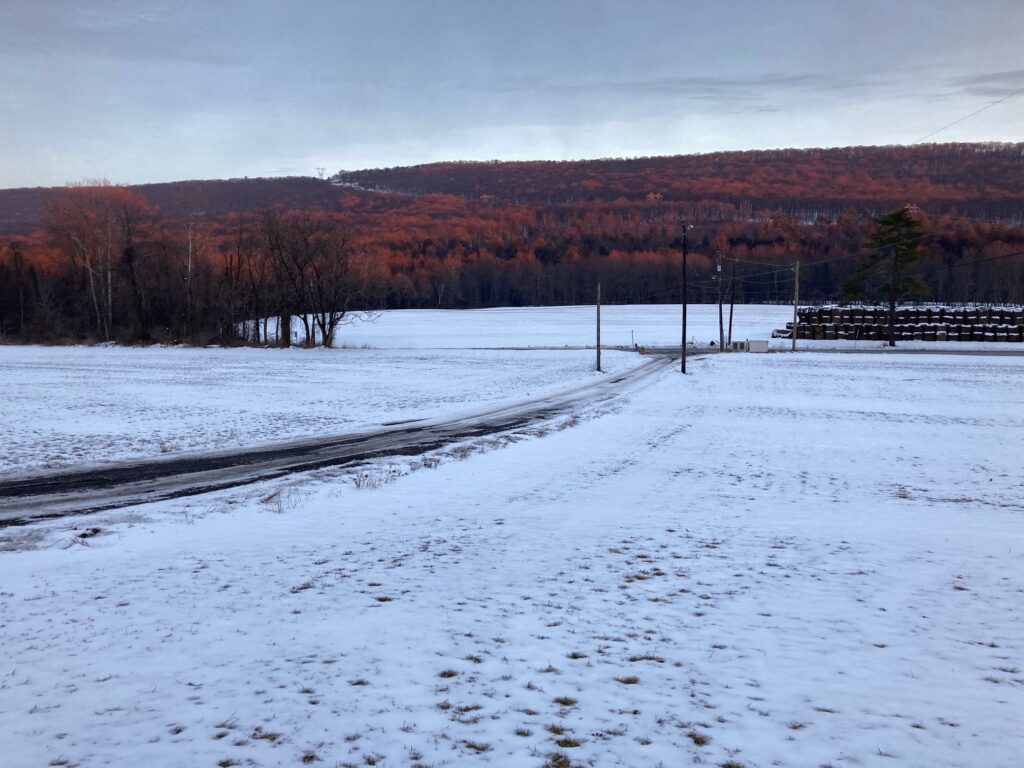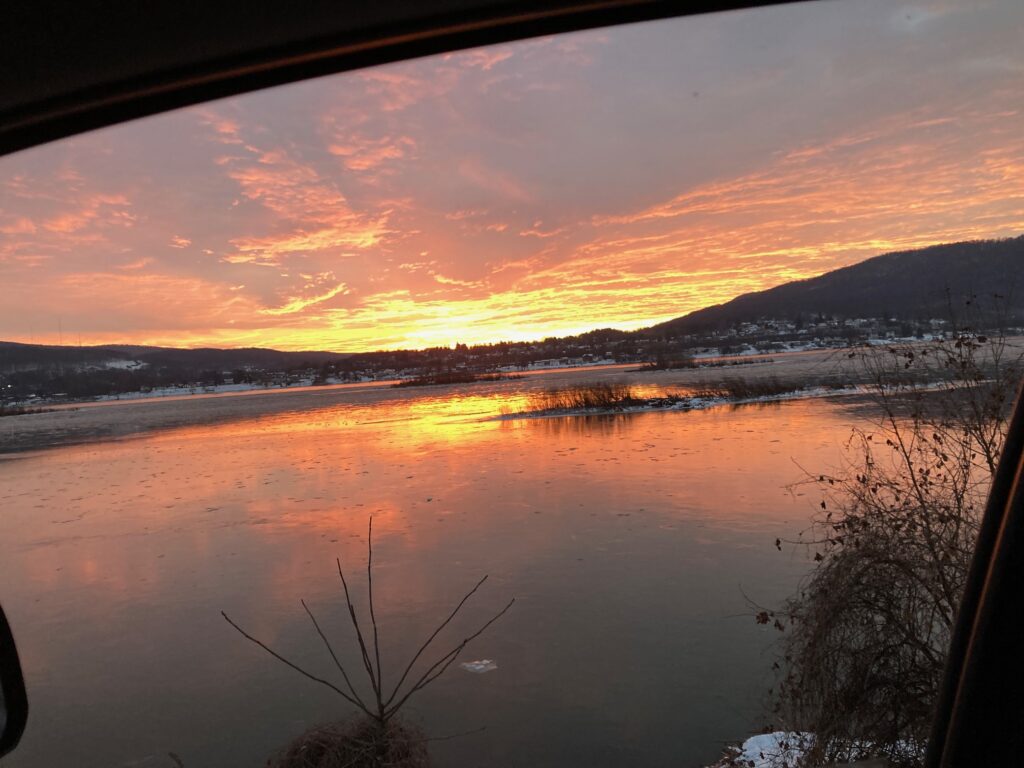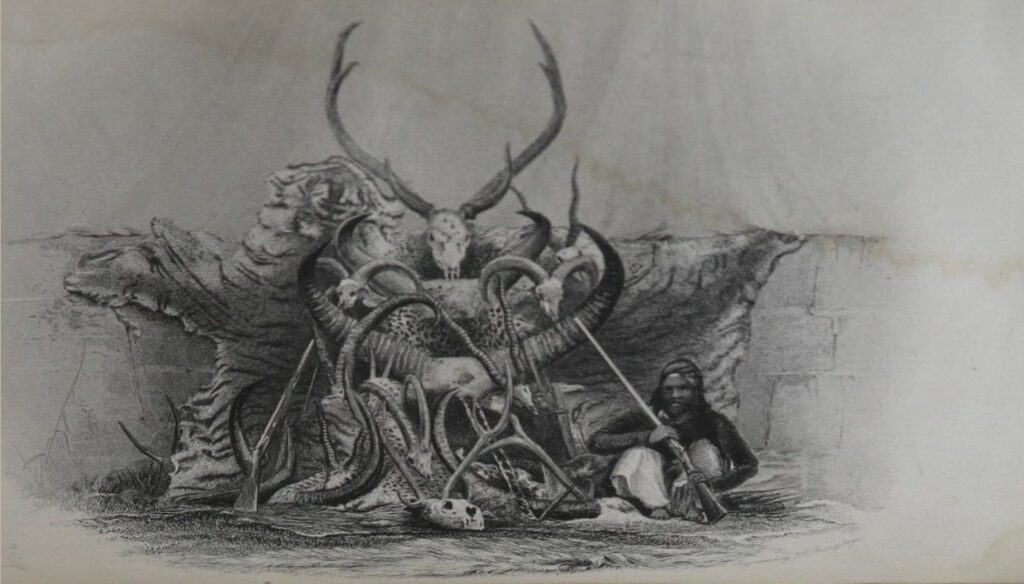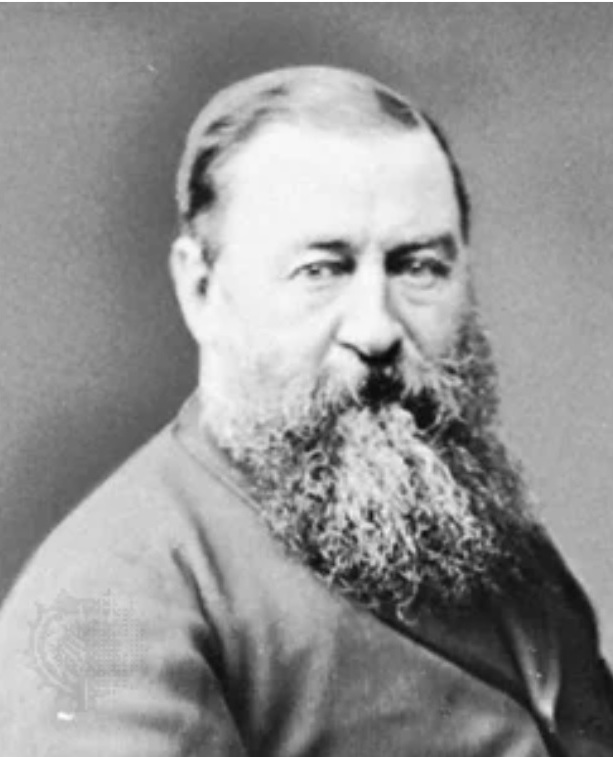Posts Tagged → reload
Reviewing the Marlin 1895 SBL
I have had some Marlin rifles, and what American deer, bear, or small game hunter doesn’t have one or two along the way in a life in the woods. But I never got so excited about one of them that I needed to join an online forum to discuss them and compare notes on handloads (handloads are non-commercial ammunition loaded by hand by the end-user, on a personally owned loading press, allowing the shooter to tailor ammunition to exacting tolerances and specific uses). This changed with the purchase of a new Ruger-made Marlin 1895 SBL, which I am really liking (after sending it back for much needed warranty work immediately after taking possession of it brand new in the box from the factory – ahem).
Overview
The new Ruger-made Marlin 1895 SBL (https://www.americanrifleman.org/content/2023-rifle-of-the-year-marlin-1895-sbl/) is a rugged, well designed firearm that I bought for two reasons and for two uses: It is fast shooting and unusually hard hitting within 50-60 yards for a sporting rifle, and I cannot think of a better rifle to hunt with on our bear drives here in PA and on bear hunts in Alaska.
After several months of ownership, here are my experiences with this gun.
Despite purchasing it brand new from the factory, I returned it to Marlin one day after picking it up from the gunshop, because the lever screw backed out, the action kept binding up, it was difficult to cycle the lever, had lots of sharp metal edges, and proud wood around the tang. This gun should have never been allowed out of the factory in the first place, and yet the buyer demand is so high that there must be pressure on the factory to just sling them out the door. According to reports made by other new owners, my experience is not unique. Ruger Marlin is going to kill their golden goose if they keep up this sloppy behavior. The gun is being sold on its presumed high quality.
The “Improved, slimmer” Forearm
While Marlin touts that the new, improved 1895 SBL forearm is slimmer than the old one, it is still too fat. This forearm is hardly easy to handle, and is not slim by any definition. It can easily use another 1/8” shaved off each side, or more, and tapered, like a shotgun forearm. That is, if you mean what you say about the forearm being easier to handle, dear Marlin.
Floppy Trigger Syndrome
The SBL’s factory trigger is pretty good, though it could be better. It is almost crisp, with a very defined and short step of creepy travel, and no stacking, but is a bit heavier than I and other users would like. It works well as a hunting trigger, which is all it really has to do anyhow. I don’t think this trigger was designed by a liability-minded lawyer. Other reviewers have reported that their 1895 SBL triggers were coming in between 5.5 to 8.5 pounds pull weight, and I am just guessing that this particular gun’s trigger is around 5.5 pounds. My preference would be in the 2.5-4.0 pound pull weight range, but I do not believe this factory trigger is adjustable. So “it is what it is,” as that tired old cliché goes, though there are superior aftermarket triggers available (https://www.wildwestguns.com/product/trigger-happy-kit/). One thing I do not like about the factory trigger is that it flops around and can make a tiny metallic sound. It would be preferable that it be stationary, locked in place, and not make noise. Because it’s on a hunting gun, and hunters require stealth. Nonetheless, the factory trigger works well as-is, and it certainly could be a lot worse.
One Rugged Beast
The SBL is one well made and tightly built rugged beast, and I think this is one of the main reasons for its popularity. Stainless steel and high tech laminate wood on anything, especially a firearm, mean it is made for southeast Alaska, at least, or anywhere else that is physically challenging and frequently wet and/or loaded with salt air. This is a rugged gun that should take all the wet and salty environment that could ever be encountered under normal hunting or camping conditions. The stainless steel does result in a shiny, reflective presence, however, and maybe too shiny for a hunting gun. Someone out there is going to bead blast their SBL for good reason, and thereby start a trend.
OK, I Guess Modern Hunting Guns are High Tech
Because I am a devoted black powder shooter and hunter, and because the year 1895 was the pinnacle of firearm development for people addicted to antiques and history like me, and because I prefer break-action single shots and double rifles over all other types of sporting guns, and because nicely blued or blacked steel with figured walnut make the most attractive firearms, I have heretofore been positively allergic to stainless steel and plastic modern guns. Everything about them just irked the crap out of me. Modern sporting firearms are just not appealing to me on any ground, most especially because nearly all of them are just plain ugly as hell. But in recent years I came to recognize that the most beautiful sporting arms can and likely will be destroyed by extended visits to places like Alaska, and so I came to a form of détente on this conundrum by recognizing the unique abilities of the SBL, and only the SBL. Its traditional lever action form is recognizable as quintessentially American, even in stainless and epoxy laminate.
The SBL is not only stainless steel and laminate wood that you can dig out a fox hole with, it also comes with a screw-off end cap for attaching a sound suppressor or a muzzle brake. Neither of these make any damned sense to me on this gun in the relatively quiet out-of-the-box 45-70, but whatever. People who are already crazed about suppressors and high tech gear-queer technical gobbledygook like muzzle brakes on deer cartridges will have all the joys of toys their little flaming hearts desire with this rifle’s little bells and whistles. Leave me out of it. To me, this is just a reliable, fast action mechanical gun in a caliber I can rely on in close-quarters grizzly country, end of technical story.
However, the factory attached Picatinny rail is pretty intriguing, even if it is also downright fugly as sin. It blows up and sets on fire whatever nice lines the 1895 SBL had to start with, but it is a valuable addition for those who use scopes and red dots and other training wheel tubular sighting contrivances on guns that don’t need them. I myself have not yet needed to use a scope on any gun I own, much less this lever action, and so this Picatinny rail is of no use to me. But in the interest of not “fixing” things that are not broken, I will leave it attached to my rifle and just hope it stops jabbing me in the proverbial eye every time I look at the gun.
This Gun Can SHOOT
Accuracy out of the box indicates these are being roughly sighted in at the factory with a laser bore sight, which is a good place to start shooting it in for hunting accuracy after you take possession of it. Do not take your 1895 SBL hunting out of the box! A fair amount of adjusting the rear peep sight for windage and elevation was necessary to get this one dialed in point-of-aim at 70 yards, which is the likely range I will be using it (see below for the deer I took with it this week at a measured 151 yards). Four shots were needed to get it centered, using the Hornady LeveRevolution 325 grain FTX, which is pretty much the standard factory ammunition designed for this gun.
Reloaders be aware that the loaded Hornady FTX brass is trimmed back shorter to accommodate the long ogive on their polymer-tipped FTX bullet that comes with their factory ammunition. You might be able to reload the Hornady factory ammunition FTX empty brass, depending on which bullet you use, and I certainly will try. If you are reloading with the Hornady FTX, then the empty brass can be reloaded without any fussing or fooling around. Other bullets, I don’t know. The 45-70 brass of any manufacturer is expensive enough to warrant trying to reload each one as many times as possible.
Accuracy is excellent after dialing in the open sights. Surprisingly good. Actually, amazingly good. This is, after all, a lever action with a short barrel, and historically these kinds of guns were mostly utilitarian 3” MOA (achieving three-inch groups at 100 yards) hunting weapons. The 26” barrel Henry 45-70 I hunted with in Alaska last year was achieving 3” groups at 100 yards with both Federal and Hornady ammo, so accuracy better than minute-of-deer in this thumper cartridge is a welcome surprise, emphasis being on the surprise. The SBL is very accurate, with surprisingly tight groups. I have read about many shooters getting MOA and even sub-MOA accuracy out of the 1895 SBL. Apparently even the old problematic “Remlin” 1895s had outstanding barrels. The new Ruger Marlin barrels are apparently just as good, if not better. This lever action gun provides accuracy expected of high quality bolt actions. Impressive and most welcome.
Its Open Sights
Yes, I like open sights, as you might guess. They are all I use and have ever used, and the factory supplied rear peep sight and neon yellow front sight work very well for me, especially at the fairly close distances I intend to hunt at with this gun. The sights are light years better than the Henry 45-70 I hunted with last year. That Henry had a cheap and flimsy rear sight that would constantly readjust itself out of true, which is downright dangerous in the grizzly country I was in. And yes, I was constantly surrounded by grizzlies, and so I kept checking and fidgeting with the Henry’s flimsy rear sight. This Marlin’s rear peep sight is more rugged, but it really sticks out and so it is vulnerable to catching on things and hard hits. It could use some sort of protective arch or band, which given how ugly the Picatinny rail already is, I don’t see how such a protective piece of steel could hurt the gun’s looks any more.
Built for Speed and Comfort
The SBL is fast shooting, and despite lobbing huge hunks of ballistic lead downrange, it is also comfortable to shoot. Probably due to its weight and the purposefully big and soft butt pad, I did not notice any real hard kick from this gun. But then again I am a very large framed guy with not only a lot of muscle but also a generous helping of blubber, which is like a giant shock absorber. Consider that I also shoot a .577 NE comfortably, so don’t be looking for reports of “the 45-70 kicks like a mule” here on this blog. I find it quite pleasant at the range and also hunting.
The 45-70 is No 50-110, OK?
Due to the SBL becoming so popular, much has been made about the 45-70 as some sort of atomic cartridge. Well, it’s not. The 45-70 certainly is no 50-110, which with modern smokeless powders really is a powerful stomper, and it is no .50 Alaskan, either. The 45-70 Government cartridge is not a “Jurassic” dinosaur killer, and in most ways it doesn’t come close to “boring” 30-06 performance.
For God’s sake and Goodness Gracious, it is not anywhere close to something so powerful. Yes, this 1870s black powder case is big compared to the modern bottle-necked cases we hunters mostly use today, and it has a lot of room for powder. And yes, it holds large bullets that are double or even triple the size of the typical 120-180 grain bullets we typically use for big game these days.
But way too many, if not almost all, the online video reviews of the 45-70 cartridge and this 1895 SBL rifle are done by young men wearing cool guy sunglasses and tight short sleeved shirts that showcase their pumped up biceps, bragging up how monstrously “powerful” this “howitzer” cartridge supposedly is (accompanied by the inevitable macho heavy crunching rock guitar musak). The implication being that they are powerful and macho as heck, and you can be, too, if you just own this rifle.
So powerful, so awesome, so macho. Barf, puke. No.
Wrong, guys. Holy smokes, people, calm down. Put down the new toy and get a grip on reality. Stop and back up to the technical reality that simple science imposes on this 45-70 cartridge and on every other cartridge, for that matter. Put away the emotional nonsense, the ego, the lame desire to be seen as cool, or tough, or macho. The 45-70 is not that powerful, nor is it macho. Owning a lever action 45-70 won’t make you cool or make your you-know-what bigger.
We Americans do like our big trucks, big engines, big homes, big landscapes, and big bore firearms, no doubt. And I am all for all of that. But the 45-70 is just nowhere near what so many people promote it as, some kind of crushingly, overwhelmingly powerful “Jurassic dinosaur killer.” Even its modern loadings in the updated Speer and Hornady manuals pale in comparison to the apparently boring old .30-06 and even the .308. And 45-70 brass is prohibitively expensive, not to mention the high cost of better factory loads, which are somewhere about two fifty per round.
In short, an American deer and black bear hunter can get much better performance and value with any off-the-shelf 30-caliber rifle than with the 45-70. The 45-70 requires an awful lot of tweaking and handloading to get it into the realm of impressive. And even at its most impressive, it is still overshadowed by the boring old .30-06 for general duty. And the .270 Winchester, .308 Winchester, and proprietary Marlin rounds like the .338, too, for that matter.
Sorry to all the macho strutting young bucks on YouTube, but your new toy is not that big or impressive! Please don’t cry!
Where the 45-70 shines these days is with just a few modern smokeless powders married to just a couple really modern solid bullets, in a fast handling, fast shooting, high quality lever gun like this 1895 SBL, at relatively close range, for fast follow-up shots on tougher-than-average critters that can stomp and eat you if they get too close.
That’s it.
That little description above is the narrow application for the 45-70 cartridge that is superior to most other sporting cartridges. Put a big, heavy 50-caliber hunting round in a Winchester Model 71 lever action, or in a Winchester 1886 lever action, and the 45-70 again falls into a far distant second choice for big and dangerous game.
But neither the old Model 71 nor the Model 1886 are made in stainless steel by one of the best gun makers.
And this reason above is why I have selected the 1895 SBL in 45-70 to be my new bear hunting rifle in Alaska and for bear drives in Pennsylvania: It is rugged, fast shooting, and potentially very hard hitting at close range with solid bullets.
If I am sitting on a hillside calling to black bears, which might require a 100-150 yard shot, then I will use a longer range bolt gun or double rifle with a flatter trajectory. One guy I know of has used the 1895 SBL for big game in Africa, but again, using a very narrowly designed combination of powder and high tech solid bullet at short range (see below).
If I were simply hunting black bears in open country, at ranges up to 200 yards, with occasional grizzlies around, like southern Alaska, Montana, Wyoming and Idaho, the 1895 SBL would not be my choice. Not even in my top five choices. Rather, a more powerful rifle with a flatter trajectory would be my first choice, such as a .300-.338-.375 magnum bolt action. If I were hunting black bear way down the southern Alaskan coast, like on the islands from Juneau south, where brown bears (grizzlies) are far fewer and black bears are much more numerous, then I would take a .308 or .30-06 and dispense with the need to cover myself in case of short range ambush charges from the really dangerous bears in heavy Alaskan jungle cover.
Summed up perfectly by a federal wildlife employee who hunts big game and also dangerous game with the 1895 SBL in Alaska and Africa, who goes by the online name Tundra Tiger, “It is true: [the 45-70 Govt.] comes with a shorter effective range than some other calibers. However, if one chooses to recognize its limitations and work within them, I don’t see what the issue is [with hunting dangerous game with it].” He has taken some dangerous game in Africa with his Marlin lever action 45-70 using just one bullet, the Cutting Edge Bullets 325-grain solid brass bullet (https://cuttingedgebullets.com/458-325gr-lever-gun-safari-solid).
In Closing
I am sure that plenty of people can and will find a way to make the 1895 SBL in 45-70 round their home defense gun, their everyday big game hunting round, whatever, and that is fine. Why not, it’s a gun, which is better than nothing for self defense. It is far better than a baseball bat, which like all striking or stabbing weapons requires you to close with your opponent. And it is far better than calling 9-1-1 and waiting for your spirit to watch the EMTs zipping up your corpse in a body bag while the police show up to write a report about the crime scene. Lever actions are fast, and being mechanical, they are reliable and theoretically less susceptible to jamming problems than semi-autos, which are notorious for jams.
And lever actions have always made good hunting guns.
For most of my big game hunting, I prefer old guns shooting black powder at relatively close range that pack the same punch as the modern 45-70, or more, or more modern but still old centerfire guns of blued steel and aged walnut shooting modern bullets at woods range, in calibers like the 7x57R, 243, 308, 270, and 30-06. Like within 100 yards, without all of the unnecessary hard work trying to figure out how to make my short barreled lever action firing huge hunks of 45-caliber lead and brass with rainbow-shaped trajectories into performing like a flat shooting bolt action in a caliber nearly half the size of the 45-70.
AGAIN, this gun was purchased for just three reasons: 1) It is constructed of the most weather-resistant, durable materials possible in a firearm, stainless steel and high tech epoxy laminated wood, 2) the lever action is extremely fast, much faster than a bolt action and even than a pump action, and finally, 3) when properly loaded with the proper high-penetration solid bullets propelled by generous and safe amounts of powders like R7 and IMR4198, this modern 45-70 lever action provides the best combination of a practical stalking rifle for black bear in Alaska with a practical emergency short range defense weapon against grizzlies.
Loaded hot with the proper (heavy high quality solids going 2,000-2,100 fps) bullet, the 45-70 does its best better than most calibers within 50 yards. Only a short-barreled 12-gauge pump shotgun accurately shooting high tech heavy slugs is a superior, equally reliable defensive long arm than the properly loaded 45-70 lever action. But I would not take that same 12 gauge short barreled shotgun bear hunting, because it is really limited in range, even more limited than the 45-70.
AGAIN, I bought this gun only for a) hunting in Alaska, which is brutal on firearms, and, thus, where a stainless steel gun will do best, and b) for bear drives in northcentral Pennsylvania, where fastest-possible shooting (i.e. lever action) at short ranges in thick laurel are the norm. Our PA bear drives are brutal on guns, boots, clothing, and every other piece of gear you have. One of my friends broke his brand new Remington 7600 pump action 30-06 stock in half on one of our bear drives. Alaska is also known for eating firearms alive, especially the southeastern coastal strip, where endless rain and salt air will corrode and rust blued metal, and mildew and rot traditional walnut stock wood, in just a few days. So the Marlin 1895 SBL really fits the bill in these two tough hunting environments.
I am presently testing my own hand loads using 16:1 and 20:1 alloy cast bullets and the Cutting Edge Bullets 325 grain solid brass bullet at 1950-2100 fps. Field reports from Alaska to Africa indicate that this CEB load in the 1895 SBL is more than adequate for both hunting black bears and also for defending against attacking brown bears at powder-burn range (and yes, grizzly attacks happen frequently).
Readers interested in understanding how modern (i.e. last ten to fifteen years) bullet technology in an 1870s cartridge like the 45-70 creates a lot more flexibility and dangerous game ability (i.e. grizzly/ brown bears in Alaska) should read the following online discussion threads:
https://www.africahunting.com/threads/45-70-for-dangerous-game.6852/
And for those hunters and bystanders interested in what a properly loaded 45-70 lever action rifle can achieve against dangerous game, Vince Lupo’s reports about his African safaris are amazing: https://www.leverguns.com/articles/lupo/lupo.htm
p.s. Men and Their Personal Weapons
Men have always cherished certain weapons. A boar spear that saved your life once, a sword that swings just perfectly in battle, a custom hunting knife made specially for us and used to gut and butcher our hunted game many times, or a well-made trusty poniard on the hip in case of trouble while at market. For thousands of years we men clutch these things close, reflexively place our hand upon them when at rest, and stare at them lovingly from across the room, because they reliably work for us daily and we can always rely on them in a tight spot. And because these weapons speak to us, us men, through their beauty, and because very often they speak for us, they come to represent us. To stand for us. We identify ourselves through them.
And so I say, you men on YouTube and elsewhere are in really good company, in your admiration for the stainless steel and laminate Marlin lever actions, like this 1895 SBL. Their robust build, certain mechanical reliability, and extremely durable materials are all big draws in a world of semiauto jams and broken parts and surprise rust at just the wrong moment. This gun is the equivalent of a good heavy steel-tipped spear a thousand years ago, and it just feels right, hefts right, in our hand.
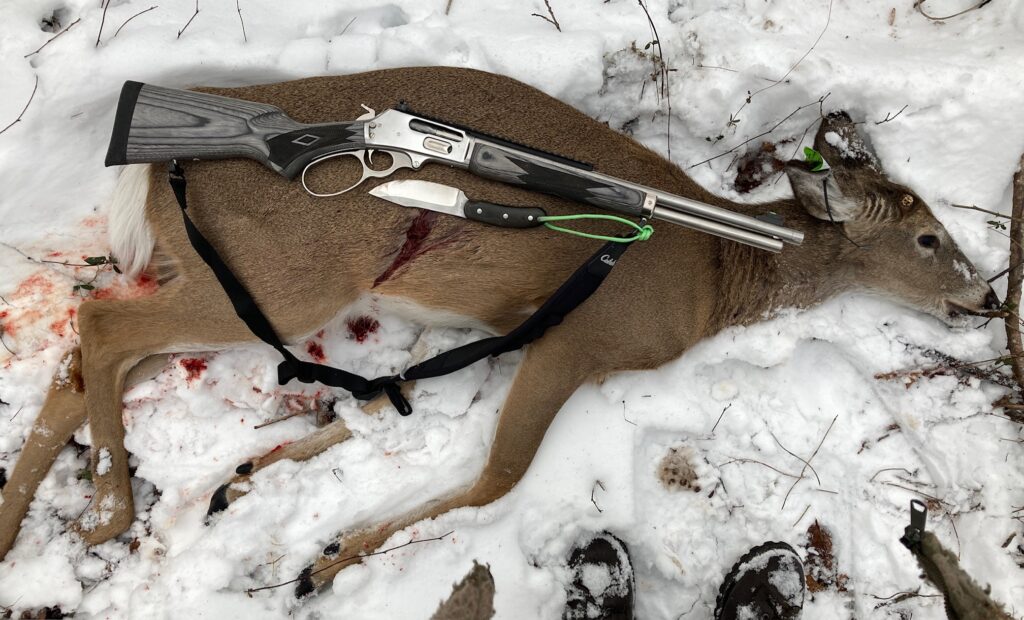
Deer I stalked and shot at 151 yards this week with the Marlin 1895 SBL. The 325-grain FTX bullet passed through lungs and stomach without slowing. Custom knife by JRJ John Johnson.
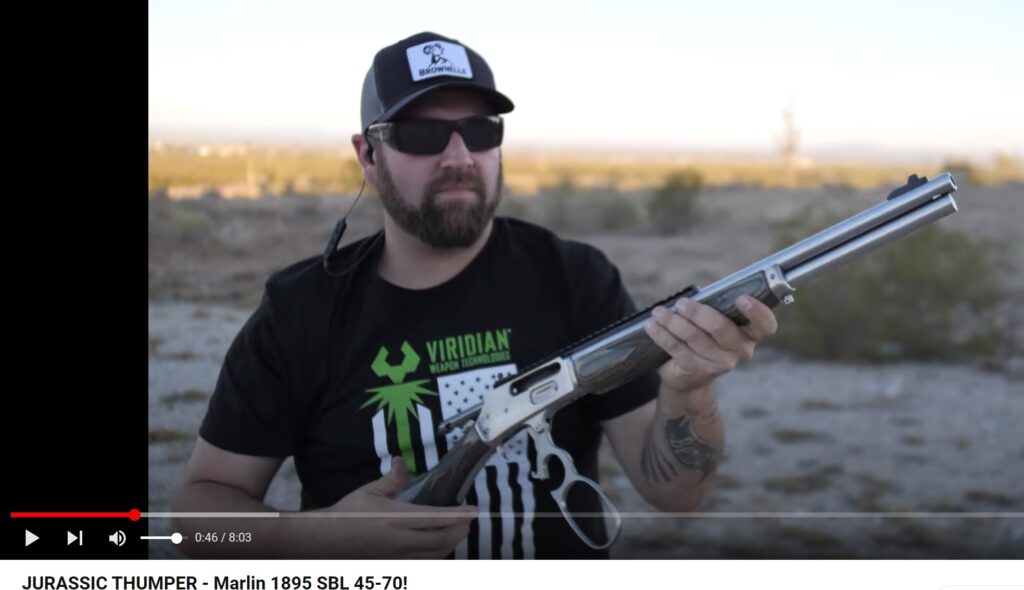
Exhibit A in macho gun reviews. Joe Cool shades in the shade. Biceps. Etc. Unfortunately, this rifle will not make his or your you-know-what bigger.

A 45-70 dangerous game round I loaded, using the 325-grain solid brass bullet by Cutting Edge Bullets. This is for stopping a grizzly
